Mapping out your marketing funnel will help you define the decision-making process and make sure you’re using the right touchpoints, messaging, and channels to help your target audience convert into customers.
The B2B Marketing Funnel for SaaS Companies
There are five stages in the B2B marketing funnel a prospective user will often move through before becoming a customer:
- They have the problem your B2B SaaS product solves, but don’t know they have the problem.
- They know they have the problem but aren’t actively looking for a solution.
- They know they have the problem and are actively looking for a solution.
- They have narrowed down the options and are comparing solutions.
- They are choosing a solution.
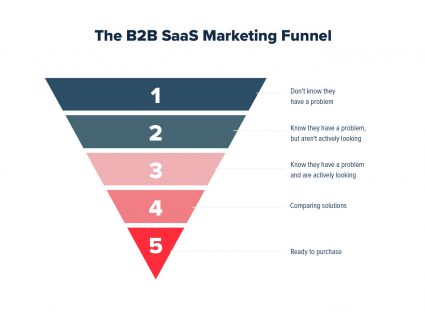
The advertising platform, the targeting within that channel, and the messaging used to reach a prospective customer can all change based on their stage in the decision-making process.
Keep in mind that prospective customers don’t always move directly from one stage of this funnel to the next.
Often, they’ll skip a stage or skip several stages—and not all prospective customers will enter your funnel at the very top.
A prospective customer might see an ad aimed at them at the top of the funnel and immediately convert from that ad alone, while a different top-of-funnel prospect might take months to move through every stage before finally converting after a long sales and nurturing campaign.
This is important to note because none of the rules we’re about to discuss will apply in every case, and it is always worthwhile to test out strategies targeting people who will move through the funnel in various ways.
You should also remember that you don’t have to map out the entire funnel at once. The lower levels of the funnel have the highest intent, and thus conversion rate, but they are also the smallest. If you haven’t run paid acquisition before, start with the lowest-hanging fruit. Target the lowest levels of the funnel first, and then map out a strategy for higher levels as you scale.
Let’s take look at all four of the pre-purchase levels of the B2B marketing funnel.
Stage 1: Don’t Know They Have The Problem
- Goal: Build awareness of the problem
- Advertising Channels: Paid social & display
- Messaging: Defining the problem, building awareness of the problem
Starting at the top of the funnel, the “awareness” level describes people who don’t know they have the problem your product solves.
Let’s say you’re an email marketing software company targeting a financial services marketing manager customer persona. That person may not even be aware yet that her manual email campaigns are costing a lot of time that could be saved using automation.
At the very top of the funnel, the goal is to make her aware she has a problem by pointing out the costs of maintaining the status quo.
Since she doesn’t yet know she has the problem your software solves, she won’t be searching for any keywords relevant to your product. That means the paid channel options at the topmost level of the B2B SaaS marketing funnel are limited to paid social and display channels like Facebook, LinkedIn, and Google Display.
If your prospect is entering the funnel at this stage, you’ll also want to be targeting her with ads promoting content and raising awareness more often than you’ll want to show her a direct response ad. It’s worth noting that you should still test direct-response ads, since she may immediately recognize the value of your product and convert.
Keep in mind that the messaging on the landing page you send her to should reflect the messaging in the ad copy. For stage 1 prospects, landing pages might feature a guide, resource, or content download that educates and builds awareness around the problem. The goal of the landing page should be capturing information to help start the nurture process.
Stage 2: Know They Have The Problem But Not Actively Looking
- Goal: Make the problem a priority
- Platforms: Paid social & display
- Messaging: Emphasize the benefits of solving the problem or the pain of not solving it
The next stage in the funnel features potential customers who know they have the problem your product solves, but aren’t actively looking for a solution. Prospects in this category may not be convinced solving the problem is a priority, budget is limited, or for a variety of other reasons.
Like stage 1 prospects, stage 2 prospects aren’t actively looking for a solution, so your ability to reach them on search is nonexistent. Once again, we turn to paid social and display platforms like Facebook, LinkedIn, and the Google Display Network.
At this stage in the funnel, the financial services marketing manager customer we are targeting knows that her manual drip campaigns are an inefficient use of time and aren’t being optimized with available data, but she’s not convinced that it’s a big enough deal to prioritize finding a solution over the other things on her to-do list.
Your ads at this stage of the funnel should promote content and messaging that hammers home awareness of the pain point, making it crystal clear to her that she should act on the problem now. Effective messaging could be something along the lines of “Did you know that the average financial services company wastes up to 2 hours a day manually sending email campaigns that could easily be automated? Find out more!”.
The goal is to get her to make solving the problem a priority, while implying that your product could be the right solution.
The landing page you send prospects to at this stage should move things beyond pure education. It could very well include educational content about the problem such as a guide or resource, but should also mention your product and introduce it as a possible solution to the problem being discussed. It should also feature a clear call to action such as signing up for a trial or scheduling a demo.
Stage 3: Know They Have The Problem, Are Actively Looking
- Goal: Build awareness of your solution
- Platforms: Paid search, paid social, and display
- Messaging: Emphasize the benefits of choosing your product
Once a prospective customer is convinced that the problem your product solves is worth solving, they’ll start actively looking for a solution. That’s when it’s time to directly pitch your product as the solution. You are now in direct response advertising territory, which is where you will probably see the highest conversion rates and shortest feedback loop from lead to paying customer.
If you can only choose one stage of the funnel to focus on due to resource constraints, this is the stage to focus on.
For the first time, you can use paid search to capture search intent. That doesn’t mean you should eliminate paid social and display, as they can both be viable channels at this stage. The challenge at this stage is identifying audiences who are actively looking for a solution, which can be more difficult on paid social and display. As we’ll discuss later in this guide, there are targeting methods on specific advertising platforms that will help you overcome this challenge.
Your ads should focus on generating awareness of your solution (instead of awareness of the problem) and emphasizing benefits and points of differentiation so prospects will consider your solution over potential competitors.
Let’s check in with our email marketing B2B SaaS company. Your ads at this stage need to show how your product easily and effectively automates the financial services marketing manager’s manual email marketing campaigns better than any other solution. Depending on the advertising platform and target audience, integrating vertical-specific or job-position specific use cases in your messaging can help convince her that she doesn’t need just any solution, but your solution in particular.
The landing page for traffic at this stage of the marketing funnel should be squarely pushing towards a signup or demo request. Showcase how your product solves the prospect’s pain points, along with information on its other benefits and features that help the prospect understand your product’s value.
Stage 4: Have Narrowed Down Options, Are Comparing Solutions
- Goal: Show that your solution is the best option
- Platforms: Paid social, display & search
- Messaging: Communicate advantage of choosing your product, create sense of urgency
The final level of the funnel relevant to paid acquisition is when a prospective customer has narrowed down options and are in the process of actually selecting a solution. At this level, the prospective customer is comparing solutions to determine which is best for them. They’ll be weighing the pros and cons of each solution they’re considering before making a final decision.
At this stage, it’s always good to keep your product top of mind with remarketing on paid social and display channels, reminding the prospective customer of what you’re offering and the unique advantages of your solution over competitors.
Reminding prospects about the benefits of your product can make the difference between a prospect becoming a customer or going with a competitor.
It’s also possible that prospects in this stage haven’t yet found or considered your product but are aware of competitors’ products. An effective way to intercept some of these prospects who are only looking at competitors is to target people who are searching for your competitors on search engines. This is called conquesting and it can be a good way to reach a high intent audience who may not have previously heard about your product.
In addition to messaging about your product’s benefits and unique features, it’s often effective to utilize available promotions to create a sense of urgency and scarcity. Offers like taking “50% off for a limited time” can help motivate prospects to consider you over your competitors.
Your landing page at this stage should emphasize your product’s points of differentiation, build a sense of urgency, and succinctly communicate why your product is the best option. Be sure to feature a strong call to action, encouraging prospects to sign up for a trial, schedule a demo, etc.


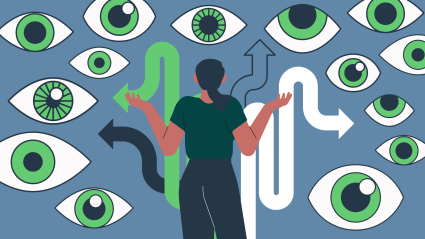
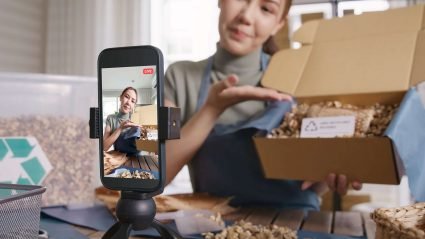

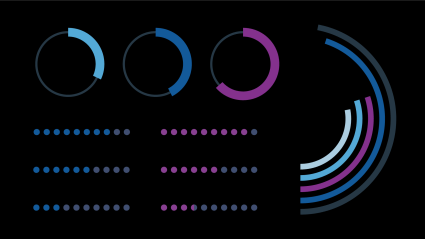
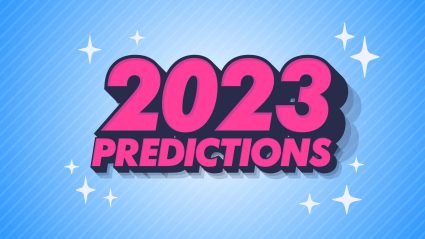
Responses